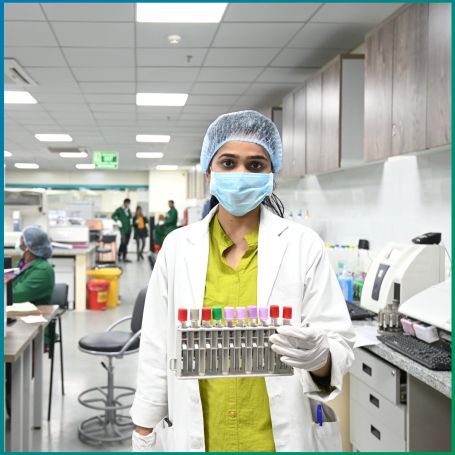
Brucellosis, a zoonotic disease caused by the Brucella bacteria, is a significant public health concern, especially in areas where animals are commonly raised for food and dairy production.


The infection can be transmitted to humans through direct contact with infected animals, consumption of unpasteurized dairy products, or inhalation of aerosolized bacteria. Infected individuals may experience a variety of symptoms, including fever, joint pain, fatigue, and malaise. Diagnosing brucellosis requires specific tests to identify the presence of the Brucella bacteria or antibodies against it in the patient's body.
1] Blood Sample Collection: A healthcare professional draws a small sample of blood from the patient, typically from a vein in the arm. This is usually done in a clinical or laboratory setting.
2] Laboratory Testing: The blood sample is processed in a laboratory where Brucella antibodies are detected using various immunoassay techniques, such as Enzyme-Linked Immunosorbent Assay (ELISA) or Indirect Immunofluorescence Assay (IFA). These techniques allow for the detection of IgG and IgM antibodies specific to Brucella.
3] Result Interpretation:
A] IgM Antibodies: IgM antibodies are produced early in an infection, usually within the first few weeks. A positive IgM result suggests a recent or acute Brucella infection.
B] IgG Antibodies: IgG antibodies develop later in the infection, often appearing a few weeks to months after the initial exposure. A positive IgG result indicates past infection or chronic brucellosis. High levels of IgG may also suggest a current or persistent infection.
The presence of both IgG and IgM antibodies suggests an active or ongoing infection. However, it is important to note that false positives and false negatives can occur, so this test is often combined with other diagnostic methods, such as blood cultures, PCR tests, or brucellosis agglutination tests, to confirm the diagnosis.
1] Positive IgM and Positive IgG: Suggests a current or active Brucella infection, requiring immediate treatment and further diagnostic testing to confirm the specific strain of Brucella involved.
2] Positive IgG and Negative IgM: Indicates past infection or a chronic brucellosis infection. This could also mean previous exposure to Brucella that the immune system has already fought off.
3] Negative IgM and Negative IgG: Indicates that the person has not been exposed to Brucella or is in the early stages of infection before antibodies are detectable.
Diagnopein Diagnostic Centre in Pune provides reliable and accurate testing for Brucella antibodies IgG/IgM. Our lab uses state-of-the-art diagnostic technology to ensure precise results, with fast turnaround times to help you receive timely care. Our expert clinicians and pathologists carefully interpret the results to provide the most accurate diagnosis and guide you through appropriate treatment options.
If you're at risk for brucellosis or have symptoms suggestive of the disease, choosing Diagnopein ensures that you receive expert care, fast diagnosis, and effective management of your health.
A blood sample is drawn from the patient, and it is tested in a laboratory for the presence of IgG and IgM antibodies specific to Brucella species. The test is typically done using immunoassay techniques like ELISA or indirect immunofluorescence.
The test involves a simple blood draw, which may cause minor discomfort or a small prick at the injection site.
Results from the Brucella Antibodies IgG/IgM Test usually take 2 to 7 days, depending on the laboratory's processing time.
While this test is reliable for diagnosing brucellosis, it can occasionally yield false positives or false negatives. Additional tests such as blood cultures or PCR tests are often recommended to confirm the diagnosis.